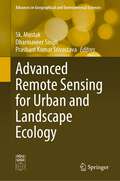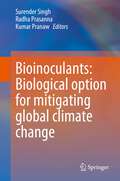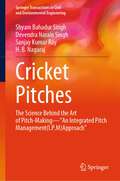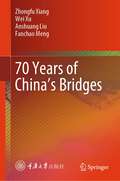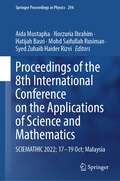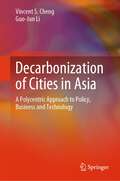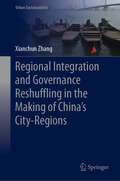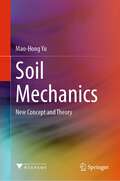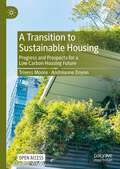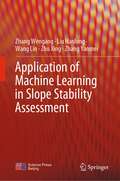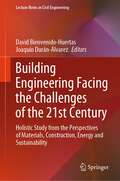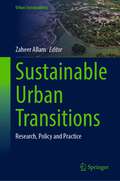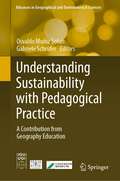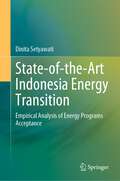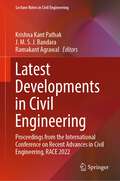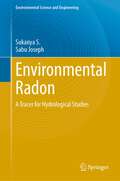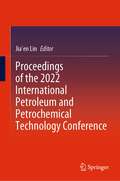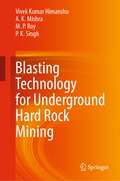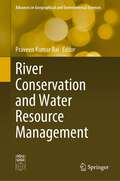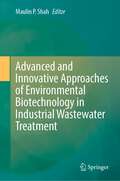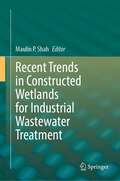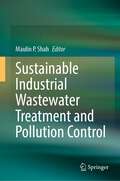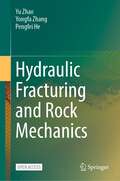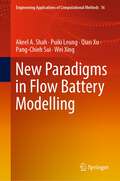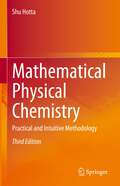- Table View
- List View
Advanced Remote Sensing for Urban and Landscape Ecology (Advances in Geographical and Environmental Sciences)
by Sk. Mustak Dharmaveer Singh Prashant Kumar SrivastavaThis book introduces the use of various remote sensing data such as microwave, hyperspectral and very high-resolution (VHR) satellite imagery; mapping techniques including pixel and object-based machine learning; and geostatistical modelling techniques including cellular automation, entropy and land fragmentation. Remote sensing plays a vital role in solving urban and environmental challenges at the landscape level. Globally, more than half of the urban population is facing severe environmental and social challenges, especially those relating to climate change, agricultural land encroachment, green infrastructure and environmental degradation, mobility due to rapid rural–urban transformation and anthropogenic interventions. Mapping and quantification of such threats at the landscape level are challenging for experts using traditional techniques; however, remote sensing technology provides diverse spatial data at a varying scale, volume and accessibility for mapping and modelling, and it also analyses challenges at urban and landscape levels. Together, they address challenges at urban and landscape levels to support the Sustainable Development Goals (SDGs).
Bioinoculants: Biological Option for Mitigating global Climate Change
by Surender Singh Radha Prasanna Kumar PranawThis edited book covers various bioinoculants for sustainable crop production under the changing global climate. The book envisages a compilation of articles relevant to the current status of production and use of novel microbial inoculants for different crops and highlights their role in mitigating global climate challenges. These include nutrient deficiencies, salinity, drought, and emerging pathogens. In addition, success stories and commercialization aspects are also discussed. Growing environmental concerns related to climate change can potentially decrease the global yield capacity of agricultural systems. Agricultural productivity is severely affected by major biotic and abiotic factors. The phytomicrobiome plays a critical role in the survival of the holobiont, particularly for plants growing in extreme environments. The use of microbial-based agricultural inputs has a long history, beginning with a broad-scale rhizobial inoculation of legumes in the early twentieth century. Microbial inoculants are considered one of the best and most effective strategies for sustainable agriculture under climate change, and a viable solution to meet the twin challenges of global food security and environmental sustainability. It is therefore imperative to understand the current status and development in the area of bioinoculants from a global perspective. The chapter’s focus would be on major agro-ecologies, covering all major crops across the globe, along with the commercialization status of different bioinoculants in different countries The book caters to the needs of the students, faculty, policymakers, and researchers working in the area of microbiology, biotechnology, environmental sciences, and botany.
Cricket Pitches: The Science Behind the Art of Pitch-Making—“An Integrated Pitch Management (I.P.M) Approach” (Springer Transactions in Civil and Environmental Engineering)
by Shyam Bahadur Singh Devendra Narain Singh Sanjay Kumar Ray H. B. NagarajThe book develops a practical understanding of the fundamental scientific principles and logic underlying the art of turf pitch preparation, measuring, analysing, and interpreting pitch surface behaviour. It’s an attempt to understand how the captains, players, coaches, curators, and groundsmen comprehend and analyse the cricket pitch behaviour (days before and during the matches) and whether the pitch behaviour can be standardised and quantified (through bench marking or forming a data-based management system (DBMS) of a pitch profile, pitch quality standards, a pitch behaviour analysis index (PBAI), or pitch behaviour forecasting (PBF) by examining or analysing its mineralogical, chemical, physical, or morphological compositions, weather variables, and different pitch preparation methods and techniques. Individual chapters in this book deal with clay mineralogy, the bench-marking of cricket pitch soils, pitch soil chemical properties, pitch soil water, pitch turf grass, pitch soil organic matter, integrated rolling management, soil structure, and compressibility. This is an effort to decipher the impact of each and every major and minor component of pitch soil, which controls the pitch behaviour either in large or small magnitudes but acts as a critical factor in defining and shaping the pitch behaviour as a whole. Several real-life examples, pitch interviews, scenarios, and case studies as felt and observed by the curator( first author) during the preparation of various international, national, and board matches or during the construction and renovation of new wickets have been included in each and every relevant chapter so as to analyse, interpret, comprehend, and justify the theoretical science with the existing practises involved in pitch construction, preparation, or judging the complex nature of pitch behaviour. Based on findings through the DBMS, PBAI, and PQS of cricket pitch profiles, various innovative and simple methods of analysing, comprehending, and forecasting pitch behaviour have been devised that will enable one to judge and comprehend the complex pitch behaviour in simple ways.
70 Years of China’s Bridges
by Zhongfu Xiang Wei Xu Anshuang Liu Fanchao MengThe book takes time as the axis, selecting 98 bridges (or bridge groups) across the country and 7 representative bridges out of the country, reflecting the steps and development of China's bridge construction in related majors and engineering technicians in colleges and universities. This book aims to let the general public understand the arduous history of China's bridge construction and the rapid development of China's bridge construction without the country's economic development, strength, and hard work of the bridge people. It is also hoped that the public will enjoy the convenience of bridges, highways, railroads, and urban roads and at the same time enhance their awareness of bridge knowledge, knowledge, love, and scientific use of bridges. This book is used by the general public to understand the development of China's bridge construction, but also as a reference book for teachers and students of bridge engineering-related majors and engineering technicians in colleges and universities.
Proceedings of the 8th International Conference on the Applications of Science and Mathematics: SCIEMATHIC 2022; 17—19 Oct; Malaysia (Springer Proceedings in Physics #294)
by Aida Mustapha Norzuria Ibrahim Hatijah Basri Mohd Saifullah Rusiman Syed Zuhaib Haider RizviThis book presents peer-reviewed articles and recent advances on the potential applications of Science and Mathematics for future technologies, from the 8th International Conference on the Applications of Science and Mathematics (SCIEMATHIC 2022), held in Malaysia. It provides an insight about the leading trends in sustainable Science and Technology. Topics included in this proceedings are in the areas of Mathematics and Statistics, including Natural Science, Engineering and Artificial Intelligence.
Decarbonization of Cities in Asia: A Polycentric Approach to Policy, Business and Technology
by Vincent S. Cheng Guo-Jun LiThis book provides best practices for decarbonizing cities in East Asia, in which buildings are the major contributor to carbon emissions. Beyond the global commitment through the Paris Agreement to make collective efforts on climate action and accelerated policies, investment and development at the country and city level to combat climate change are occurring at an unprecedented rate. Rapid urbanization and increasing energy demand for large and dense Asian cities require smart and sustainable strategies to balance development with decarbonization. A poly-centric approach is needed, where a combination of policy-, market- and technology-driven changes can aid the transition towards development of carbon neutral cities. With practical examples in the implementation of the United Nations Sustainable Development Goals, green financing, climate action roadmap and policy, deployment of renewable energy, and low- to zero-carbon buildings, readers can find the motivation, considerations and implementation pathways to facilitate the transition into the new normal. It is the hope of the authors to encourage readers to see successful pathways in transitioning into a carbon-free industry and overcoming the effects of climate extremes.
Regional Integration and Governance Reshuffling in the Making of China’s City-Regions (Urban Sustainability)
by Xianchun ZhangThis book for the first time thoroughly investigates the extent of economic and institutional integrations and the underlying governance reshuffling process of China’s city-regionalism. By using the Shenzhen-Dongguan-Huizhou sub-region (SDH) in southern China as an empirical case, this book provides convincing evidence that China’s city-regionalism is essentially a state-orchestrated and institution-based process. Perspectives from “market-industry-infrastructure” and multi-level governance (MLG) have been provided to systematically examine China’s city-regionalism. This book has essentially made a definitive contribution to China’s regional governance. Methodologically, it shows how China’s city-regionalism can be examined through a problem-solving and case-by-case paradigm, through building a bridge between an empirical slogan and an inclusive theoretical term for institutional integration and through MLG and its integrative approaches in China. Exhilarating findings are presented using extensive tables, graphs, and maps along with the integration of quantitative and qualitative methods. Undergraduates, graduates, and researchers who are interested in China’s city-regionalism and regional governance would be the readership of the book, and officers from different levels of government as well as policymakers will find the book inspiring.
Soil Mechanics: New Concept and Theory
by Mao-Hong YuThis book focuses on the unified solutions and analysis for the problems in soil mechanics based on the unified strength theory, which is a new theory on the yield and failure of materials under multi-axial stresses. Then, it provides a system of yield and failure criteria adopted for most materials, from metallic materials to rocks, concretes, soils, polymers, etc. It includes the Tresca criterion, Mohr–Coulomb theory, and Mises criterion as well, which are special cases or linear approximation of the UST.
A Transition to Sustainable Housing: Progress and Prospects for a Low Carbon Housing Future
by Trivess Moore Andréanne DoyonThis open access book explores the environmental, social, and financial challenges of housing provision, and the urgent need for a sustainable housing transition. The authors explore how market failures have impacted the scaling up of sustainable housing and the various policy attempts to address this. Going beyond an environmental focus, the book explores a range of housing-related challenges including social justice and equity issues. Sustainability transitions theory is presented as a framework to help facilitate a sustainable housing transition and a range of contemporary case studies are explored on issues including high performing housing, small housing, shared housing, neighbourhood-scale housing, circular housing, and innovative financing for housing. It is an important new resource that challenges policy makers, planners, housing construction industry stakeholders, and researchers to rethink what housing is, how we design and construct it, and how we can better integrate impacts on households to wider policy development.
Application of Machine Learning in Slope Stability Assessment
by Zhang Wengang Liu Hanlong Wang Lin Zhu Xing Zhang YanmeiThis book focuses on the application of machine learning in slope stability assessment. The contents include: overview of machine learning approaches, the mainstream smart in-situ monitoring techniques, the applications of the main machine learning algorithms, including the supervised learning, unsupervised learning, semi- supervised learning, reinforcement learning, deep learning, ensemble learning, etc., in slope engineering and landslide prevention, introduction of the smart in-situ monitoring and slope stability assessment based on two well-documented case histories, the prediction of slope stability using ensemble learning techniques, the application of Long Short-Term Memory Neural Network and Prophet Algorithm in Slope Displacement Prediction, displacement prediction of Jiuxianping landslide using gated recurrent unit (GRU) networks, seismic stability analysis of slopes subjected to water level changes using gradient boosting algorithms, efficient reliability analysis of slopes in spatially variable soils using XGBoost, efficient time-variant reliability analysis of Bazimen landslide in the Three Gorges Reservoir Area using XGBoost and LightGBM algorithms, as well as the future work recommendation.The authors also provided their own thoughts learnt from these applications as well as work ongoing and future recommendations.
Building Engineering Facing the Challenges of the 21st Century: Holistic Study from the Perspectives of Materials, Construction, Energy and Sustainability (Lecture Notes in Civil Engineering #345)
by David Bienvenido-Huertas Joaquín Durán-ÁlvarezBuilding engineering is a complex and constantly evolving branch. The needs of the XXI century society cause a constant change in construction industry due to the need to achieve sustainable and ecological buildings. This affects all levels and phases of this engineering. Given this circumstance, numerous researchers turn their efforts to find optimal solutions for building engineering. For this reason, in this book a holistic analysis of building engineering is carried out from the perspectives that have a greater weight for sustainability objectives. The book is divided into 6 sections: (i) Building materials, which deals with research related to the most innovative and sustainable building materials; (ii) Design and construction, which deals with existing methodologies and advances in design and construction in construction sector; (iii) Building repair and maintenance, which deals with building repair, maintenance and upkeep techniques; (iv) Energy efficiency, which analyses the latest research on the energy efficiency of buildings and their behaviour in the face of climate change; (v) Sustainability, which analyses the establishment of measures to achieve a more sustainable built environment; and (vi) construction management, which compiles the latest studies in the field of Project manager. The 38 chapters of the book together constitute an advance for the topic of building engineering. The aspects covered in the book are of great interest to various sectors, such as researchers, engineers, architects, legislators and interested parties.
Sustainable Urban Transitions: Research, Policy and Practice (Urban Sustainability)
by Zaheer AllamThis book aims to explore how sustainability transitions can be explored in current and future cities and how research and policy approaches can be applied to change urban life as we know it, hence aligning the two thematic of urban science and future science, for achieving deep decarbonization. On this, the discourse on philosophy, ethics, and morality appertaining to sustainable cities and urban transitions, across disciplines, are also welcomed as it provides a deeper understanding of humanity in future scenarios. Chapter 08 is available open access under a Creative Commons Attribution 4.0 International License via link.springer.com.
Understanding Sustainability with Pedagogical Practice: A Contribution from Geography Education (Advances in Geographical and Environmental Sciences)
by Osvaldo Muñiz Solari Gabriele SchrüferThis book shares with an international audience of teachers, scholars, and policymakers the experience of pedagogical practices to facilitate sustainability in the world. Sustainability is seen here as a journey toward the end state of sustainable development. Therefore, the authors contribute different roads to engage teachers and students with pedagogical discourse. Overall, the book demonstrates the value of powerful knowledge through action-oriented learning based on a bottom-up process. Consequently, pedagogical practices are understood as the instructional approaches based on a social constructivist model in which active learning is performed with student-to-student engagement. Secondary teachers in social sciences and university professors in geography find the study to be a valuable source of stimulation for incorporating new ideas and resolving common problems in their learning and teaching environments. Education policymakers around the world also benefit from the only publication that presents international perspectives on geographical knowledge related to sustainability.The contributing authors are experienced scientists in the field of geography education who are giving special attention to pedagogical practices that promote new directions toward sustainable thinking.This book is the first outcome of an international collaboration officially established in 2023 between the Department of Geography and Environmental Studies at Texas State University and the Department of Geography at the University of Bayreuth.
State-of-the-Art Indonesia Energy Transition: Empirical Analysis of Energy Programs Acceptance
by Dinita SetyawatiThis book discusses how people can come together to address current energy justice and access poverty problems by examining the relationship between energy systems and society in diverse energy sources. The novelty of this book is that this is the only complete guide for readers who wish to understand the status of Indonesia’s energy transition and renewable energy development. Energy programs that are explored are the ones prioritized by government administrations, including coal, nuclear power, solar energy, green electricity, and geothermal energy. Based on extensive fieldwork and empirical data, the book combines insights from historical data on energy subsidies and economic diversification, current empirical data on social acceptance of new energy technologies, and contemporary studies that forecast the implications of the transition to the coal industry and fossil fuel subsidies. It asks how Indonesia has enacted policies that support energy transition. How do the public and civil society view those policies? What are the implications for broader themes and discussions on energy sources, technology, systems, policies, and service? Strategies are suggested to advance a sustainable transition in the developing world that will mitigate developmental risks associated with the transition away from fossil fuels while encouraging decision making in a sustainable and socially just manner. This book is an informative and engaging read for a general audience as well as a valuable resource for scholars, researchers, and students in environmental and energy studies.
Latest Developments in Civil Engineering: Proceedings from the International Conference on Recent Advances in Civil Engineering, RACE 2022 (Lecture Notes in Civil Engineering #352)
by Krishna Kant Pathak J. M. S. J. Bandara Ramakant AgrawalThis book comprises select proceedings of the International Conference on Recent Advances in Civil Engineering (RACE 2022). The contents of this book focus on the recent advancements and innovations in the field of civil engineering and various related areas such as design and development of new sustainable and smart building materials, performance analysis and simulation of steel structures, design and performance optimization of concrete structures, structural engineering, geotechnical engineering, water resources engineering and hydraulics, transportation and bridge engineering, building services design, surveying and remote sensing, engineering management and renewable energy. This book serves as a useful reference to researchers and professionals in the field of civil engineering.
Environmental Radon: A Tracer for Hydrological Studies (Environmental Science and Engineering)
by Sukanya S. Sabu JosephThis book presents state-of-the-art techniques on radon (222Rn) in the environment, including measurement techniques in air, soil and water and its potential applications to various hydrological investigations, especially for water resources development and management. The future directions of its use are also discussed.As a radon tracer can be used to solve hydrological issues, the highlights of this book are useful for stakeholders to achieve UN Sustainable Development Goal 6, which addresses the sustainability of water resources. The most relevant target audiences are hydrologists, hydrogeologists, geologists, environmental scientists, nuclear physicists, hydraulic engineers and academicians, among others. This book also covers health implications of radon and mitigation strategies, thus creating a valuable resource for health physicists working on environmental radiation safety as well.
Proceedings of the 2022 International Petroleum and Petrochemical Technology Conference
by Jia’en LinThis book is a compilation of selected papers from the 6th International Petroleum and Petrochemical Technology Conference (IPPTC 2022). The work focuses on petroleum & petrochemical technologies and practical challenges in the field. It creates a platform to bridge the knowledge gap between China and the world. The conference not only provides a platform to exchanges experience but also promotes the development of scientific research in petroleum & petrochemical technologies. The book will benefit a broad readership, including industry experts, researchers, educators, senior engineers and managers.
Blasting Technology for Underground Hard Rock Mining
by Vivek Kumar Himanshu A. K. Mishra M. P. Roy P. K. SinghThis book presents the principles and practices of rock blasting for underground hard rock mining. It covers a theoretical background of the rock blasting technology and comprehensive case studies on different stages of rock blasting for underground metalliferous mining. It includes the discussions on burn-cut face blasting pattern, slot raise excavation methodology, and ring blasting methods. It further discusses different practical challenges associated with underground blasting, viz. ore dilution, ground vibration, wall instability, etc., and their possible solutions. The book also covers the recent advancements in methodologies to predict blasting outcomes and instrumentations for monitoring rock blasting operations. The book is a useful reference for rock blasting practitioners, mining engineers, professionals, and researchers. It is also a valuable reference for undergraduate and postgraduate students.
River Conservation and Water Resource Management (Advances in Geographical and Environmental Sciences)
by Praveen Kumar RaiThis book presents an up-to-date, systematic and scientific analysis of water resource problems in India and suggests measures to overcome them through effective water management. In addition, the book provides an overview of how changes in legislation, policies, institutional responsibilities, science, technology, practical techniques and public perception have influenced the ways of river management over the past years. River water conservation is a planned activity connected with various habitat features and outlines how to conserve all river water spread across the world. The restoration and conservation of river water must be of the highest priority for sustaining humanity and ecology for the present and future generations. In order to solve the water problems, conservation and recycling of water should be made mandatory for all domestic, industrial and agricultural projects. Apart from the priority to watershed development, rainwater harvesting and other appropriate conservation measures should be adopted to create awareness among the public so that their mind-set, attitudes and habits change proactively and they adopt sustainable practices rather than wait for legislation and regulations. The book augments the knowledge base of behaviour of rivers and evaluates the issues related to rivers so as to develop river system management techniques emerging from in-depth scientific analyses. It is useful for students, researchers, water resource managers, hydrologists and all those who are engaged or interested in any aspect of river water conservation and management of water resources in the country.
Advanced and Innovative Approaches of Environmental Biotechnology in Industrial Wastewater Treatment
by Maulin P. ShahThis book discusses new and innovative trends and techniques in the removal of toxic and refractory pollutants by means of various microbial biotechnology processes from wastewater, both on the laboratory and industrial scales. The book also highlights the main factors contributing to the removal of toxic pollutants as well as recycling, environmental impact, and wastewater policies after heavy metal removal. In addition, it assesses the potential application of several existing bioremediation techniques and introduces new cutting-edge emerging technologies. This book significantly contributes to the wastewater treatment plant industry so that the treatment systems can serve better and more resiliently for the purpose. This book is designed for engineers, scientists, and other professionals who are seeking introductory knowledge of the principles of environmental bioremediation technology and for students who are interested in the environmental microbiology and bioremediation fields.
Recent Trends in Constructed Wetlands for Industrial Wastewater Treatment
by Maulin P. ShahThis book examines various unique applications and their effectiveness of constructed wetlands for the treatment of complex and heavily polluted wastewater from industrial sources. It also highlights the technological and advanced knowledge in application of constructed wetlands through different microbiological and advanced biochemical technologies. Special attention is paid to suspended solids, organic matter, and nutrient removal. Deep insights are provided for facilities such as those in oil and gas industries, agro-industry, paper and pharmaceutical manufacturing, the textile industry, wineries, breweries, and sludge treatment, among others.Constructed wetlands are low-cost and sustainable systems for wastewater treatment. Traditionally, they have been used for urban and domestic wastewater treatment, but in the last two decades, applications for industrial wastewater treatment have increased due to the advances of the technology and extended research in the field. The advances have also been encouraged by the economic, environmental, and societal advantages over conventional technologies.This book helps academicians and industrialists obtain detailed knowledge about constructed wetlands in the field of wastewater treatment.
Sustainable Industrial Wastewater Treatment and Pollution Control
by Maulin P. ShahThis book summarizes the advanced sustainable trends in removing toxic pollutants by environmental and biotechnological processes from both industrial wastewater and sewage wastewater. The book also provides an assessment of the potential application of several existing wastewater bioremediation techniques and introduces new cutting-edge technologies. Among other valuable information covered, here are the methods, procedures, materials (especially low-cost materials originating from industrial and agricultural waste), management of wastewater containing toxic pollutants, and valorization possibilities of waste resulting from the removal of toxic pollutants from wastewater.Tonnes of hazardous waste pollutants released by industries are a challenge worldwide. With the ever-growing population and shrinking landfill areas, managing the disposal of pollutants is a matter of severe concern. Industrial wastewater treatment, recycling, and reuse are serious issues in today’s context, not just to protect the environment from pollution, but also to conserve water resources so that water stress is reduced.This book is designed for engineers, scientists, and other professionals and serves as a good summary of the current state-of-the-art and innovative research challenges to control pollution for coming generations.
Hydraulic Fracturing and Rock Mechanics
by Yu Zhao Yongfa Zhang Pengfei HeThis open access book is the first to consider the effect of non-uniform fluid pressure in hydraulic fractures. The book covers the key topics in the process of hydraulic fracture nucleation, growth, interaction and fracture network formation. Laboratory experiments and theoretical modeling are combined to elucidate the formation mechanism of complex fracture networks. This book is suitable for master’s/Ph.D. students, scientists and engineers majoring in rock mechanics and petroleum engineering who need to use a more reliable model to predict fracture behavior.
New Paradigms in Flow Battery Modelling (Engineering Applications of Computational Methods #16)
by Akeel A. Shah Puiki Leung Qian Xu Pang-Chieh Sui Wei XingThis book provides a comprehensive review of the latest modelling developments in flow batteries, as well as some new results and insights. Flow batteries have long been considered the most flexible answer to grid scale energy storage, and modelling is a key component in their development. Recent modelling has moved beyond macroscopic methods, towards mesoscopic and smaller scales to select materials and design components. This is important for both fundamental understanding and the design of new electrode, catalyst and electrolyte materials. There has also been a recent explosion in interest in machine learning for electrochemical energy technologies. The scope of the book includes these latest developments and is focused on advanced techniques, rather than traditional modelling paradigms. The aim of this book is to introduce these concepts and methods to flow battery researcher, but the book would have a much broader appeal since these methods also employed in other battery and fuel cell systems and far beyond. The methods will be described in detail (necessary fundamental material in Appendices). The book appeals to graduate students and researchers in academia/industry working in electrochemical systems, or those working in computational chemistry/machine learning wishing to seek new application areas.
Mathematical Physical Chemistry: Practical and Intuitive Methodology
by Shu HottaThe third edition of this book has been updated so that both advanced physics and advanced chemistry can be overviewed from a modern mathematical perspective in a single integrated book. Nowadays key research arears in physics and chemistry such as materials science, molecular science, and device physics are drawing closer and closer together and becoming more and more mathematical. Hence, while retaining the basic feature, the contents are targeted at graduate and undergraduate students majoring in not only chemistry but also physics and engineering. The book covers topics ranging from classical physics (e.g., electromagnetism and analytical mechanics) to quantum science. The latter topic includes an introduction to the quantum theory of fields as well as standard quantum mechanics and quantum chemistry. Tangible examples help readers to understand abstract concepts about the topics covered. Several major revisions have been made and they contain: (a) constitution of the Dirac equation; (b) quantization of the fields; (c) interaction between the quantum fields; (d) basic formalism related to the extended vector spaces and the transformation properties of the Dirac equation; (e) advanced topics of Lie algebra. The new edition thus supplies chemists, physicists, and engineers with fundamental knowledge and calculation methodology of mathematical physics.
